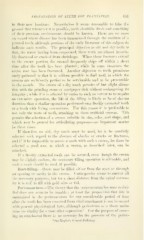Page 653 - My FlipBook
P. 653
PREPARATION OF TEETH FOR PLANTATION. 651
in their new locutions. Xevertheless it seems reasonable to take the
ground that whenever it is possible, teeth should be fresh and something
of their previous environment should be known. There are no cases
on record where disease has been transmitted through the medium of a
planted tooth, although portions of the early literature of this subject do
indicate such results. The principal objection to old and dry teeth is
that, the water having been evaporated, these teeth are almost invaria-
blv fractured or cracked from shrinkage. When these fractures extend
to the crown portion, the enamel frequently chips off within a short
time after the tooth has been planted ; while in some instances the
entire root has been fractured. Another objection to teeth promiscu-
ously gathered is that it is seldom possible to find teeth in which the
crowns are sufficiently perfect to be serviceable and to be presentable
in the mouth. The crown of a dry tooth permits of but slight altera-
tion with the grinding stone or sandpaper disk without endangering its
integrity ; w4iile if it is affected by caries to such an extent as to require
an extensive operation, the life of the filling is likely to be of shorter
duration than a similar operation performed on a freshly extracted tooth
or a tooth with living connections. For this reason it is preferable to
use only the roots of teeth, attaching to them artificial crowns. This
permits the selection of a crown suitable in size, color, and shape, and
which may be ground for articulating purposes—an important matter
in these cases.
If therefore an old, dry tooth must be used, let it be carefully
selected with regard to the absence of checks or cracks or fractures,
and if it be impossible to secure a tooth with such a crown, let there be
selected a good root to w'hich a crown, as described later, can be
attached.
If a freshly extracted tooth can be secured, even though the crown
may be sliglitly carious, the necessary filling operation is advisable, and
such a tooth should be used, if possible.
Root-filling.—Roots may be filled either from the apex or through
an opening or cavity in the crown. Gutta-percha seems to answer all
the necessary purposes, but for a short distance from the apical extrem-
ity it is well to fill with gold wire or ff)il.
Pericementum,—The theory that the pericementum becomes revivi-
fied does not seem to be tenable; at least the proposition that life is
maintained in the pericementum fi)r any considerable period of time
after the tooth has been removed from vital attachment is not in accord
with general physiological laws, although periosteum as a tissue main-
tains its vitality for a time after separation.^ For the pur])ose of secur-
ing an attachment there is no necessity for the presence of the perice-
' See Ziegler's General Pathology.


